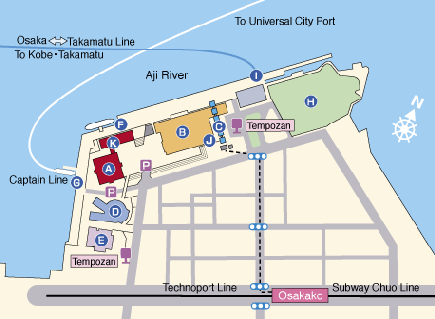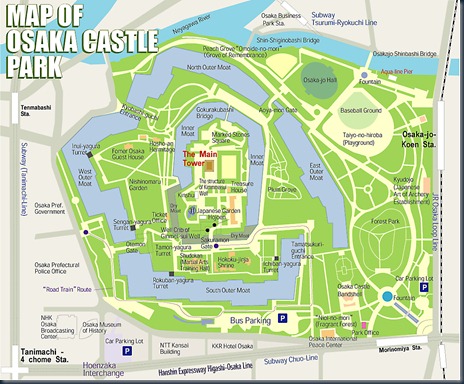by Heather Hopkins Clement
I have to start with a confession; I’m a Japanese castle snob. After seeing numerous castles throughout Japan, I simply am not a fan of recently reconstructed concrete castles. So, if my cruise ship stopped at the port of Osaka for the day and I wanted to see a Japanese castle,without a doubt my first stop would be Himeji Castle, a UNESCO World Heritage Site. As the prototypical Japanese castle, Himeji Castle is the most visited in all of Japan, and I highly recommend it.
On second thought, I guess I have another confession. After having lived and worked in Osaka, I consider it my Japanese hometown, and the castle is an iconic symbol of the city. The castle figures significantly in several major historical events of Japanese history in the feudal period. So, for historical and sentimental reasons, I still think it is well worth a visit—it just would not be my first or one and only stop in the area.
Before I go into more specifics about the castle’s cultural and historical significance, let me give you the basic info:
- Address: 1-1 Osaka-jo, Chuo-ku, Osaka City 540-0002
- Tel.: +81-(0)6-6941-3044
- Hours: 9 AM to 5 PM daily, but last entrance is at 4:30
- Admission: 600 yen for adults; free for children 15 and under; group discount available for group of 15+
- Accessibility: Elevator available. Restrooms are located on the second floor only.
- Website: http://www.osakacastle.net/english/ (also available in Chinese and Korean)
- Time Required: 2 hours+
Osaka Castle is the backdrop for some pretty interesting historical events involving the so-called “Three Great Unifiers of Japan”:
The original castle was built in 1496. During his campaign to unify the country, warlord Oda Nobunaga burned the castle to the ground in 1580. His successor, Toyotomi Hideyoshi, rebuilt the castle. Upon the death of Hideyoshi, Tokugawa Ieyasu, took control of the castle in 1615 as his consolidated his power to set up rule by Tokugawa shoguns for the next 250+ years.
The castle fell into disrepair throughout the next few centuries and was damaged by bombing raids on the city during WWII. The current structure is a concrete facade.
Inside the castle, you can view historical artifacts in the Osaka Castle Tower Museum. If you make your way to the top of the castle tower, you can enjoy a panoramic view of the city from the observation deck that stands 50 meter above the ground.
The castle grounds are a nice place to people watch too. In the early spring, it is a great place to view cherry blossoms, and you will see people out exercising and enjoying picnics together in the park. You may want to try out a local delicacy from one of the street vendors.

How to get to Osaka Castle from Tempozan Pier:
Walk about 5 minutes to the nearest subway station, Osaka-ko, on the Chuo (Green) Subway line. You will want to board the train on platform #1 to head towards the castle.
A. KAIYUKAN Aquarium
B. Market Place(shops and restaurants)
C. Giant Ferris Wheel
D. Suntory Museum
E. Hotel Seagull Tempozan Osaka
F. Osaka Bay Cruise (Santa Maria)
G. Cruise to USJ port (Captain Line)
H. Tempozan Park including Mt. Tempozan, the lowest mountain in Japan
I. Cruise to Kobe, Shodoshima island and Takamatsu in Shikoku island
J. Tourist Information
K. KAIYUKAN Information (on the second floor of Entrance Building)
A - G, J and K: Tempozan Harbor Village
From there, the fastest route is the take the green line to Tanimachi-4-chome (about 30 minutes). From that station, take the closest exit to the castle—Exit 1B. It’s about a 20 minute walk from there, so this is a good opportunity to interest with the locals to make sure you are headed in the right direction.
You can also take a slightly longer, more circuitous route to view the city from your train en route. To do so, take the Chuo (Green) Subway line from Osaka-ko to Bentencho. From there, you will need to purchase a second ticket to ride on the JR Osaka Loop lLne to Osaka-jo Koen (Osaka Castle Park) station. From here, you will still have another 20 minute walk.







 A viaduct leads us from the Railway terminal to the Passenger ship terminal. In the early 1860s the “Aleut” schooner station was located at the place. The schooner crew cut an opening to the new stone wharf at the Zolotoy rog (Golden Horn) bay. The opening had became Aleutskaya street by the end of XIX century. The first building of the passenger ship terminal was also situated there. But that building was pulled down in 1959. Architects from “Morsoyuzproekt” institute used the old walls to construct a conceptually different building – a glazed terrestrial seaward liner.
A viaduct leads us from the Railway terminal to the Passenger ship terminal. In the early 1860s the “Aleut” schooner station was located at the place. The schooner crew cut an opening to the new stone wharf at the Zolotoy rog (Golden Horn) bay. The opening had became Aleutskaya street by the end of XIX century. The first building of the passenger ship terminal was also situated there. But that building was pulled down in 1959. Architects from “Morsoyuzproekt” institute used the old walls to construct a conceptually different building – a glazed terrestrial seaward liner.



